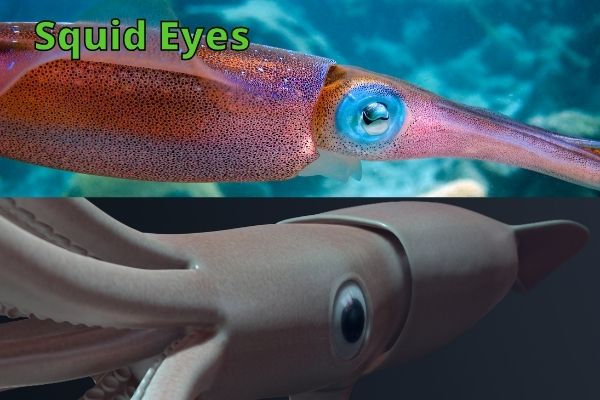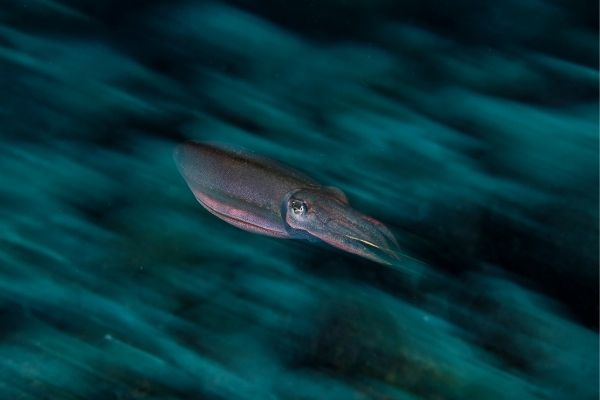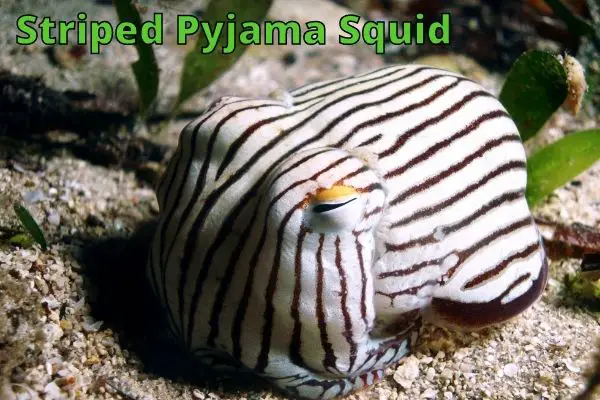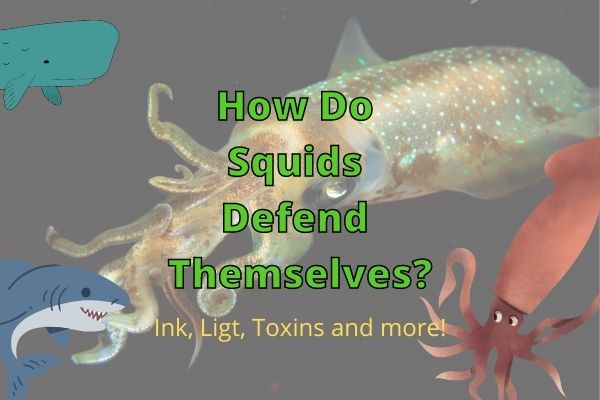Squids may look somewhat defenseless with their soft bodies and long slimy arms that are easy to rip off for a larger stronger animal. However, as I will show you, squids are not completely without tricks when it comes to defending themselves!
I recently wrote a blog post about the main predators of squid in the oceans, so check that out if you haven’t already, to get an idea about the predators we are dealing with here!
Squids have several tactics when it comes to evading predators.
First off, they have large very sensitive eyes that can spot a whale from hundreds of feet away.
Second, they can shoot out ink and change color to confuse and distract potential predators.
Third, some squids can also create bioluminescent flashes and lights to deter, or hide from, their enemies!
Fourth, although squids look soft and jelly-like; squid do have an internal shell made of hard chitin, which protects its internal organs from predators.
Fifth, the long arms and sharp beaks of squid cannot only be used for attack but also for defense! And they do not hesitate to sacrifice a limb in exchange for survival!
And finally, some squid species are venomous – producing toxins to deter their enemies!
Contents
Squids use their eyes to spot predators from afar!
A squid’s eyes are located on the sides of its head, and it has no eyelids.
The large eyes of a squid are structurally complex, containing a lens, iris, and retina. The lens is surrounded by a thin layer of muscle that can change the shape of the lens to focus light on the retina. The retina contains cells that are sensitive to light and send signals to the brain of the squid.
Giant squids use their eyes to spot predators and other objects in their environment. They have excellent vision, and can see both near and far objects clearly.
They are able to see a whale predators coming at 400 feet (~120 meters) away!
Squids evolved from primitive invertebrates that did not have eyes. Over time, they developed sophisticated eyes that helped them survive in their underwater environment.
Interestingly, very few deep sea animals have as advanced eyes as the giant and colossal squids. And it has long puzzled scientists why they would need such large eyes in the muddy and dark waters of the deep sea.
As the whales got better at holding their breath and diving deeper and for longer times, the squid’s best defense was to observe their predator in time!
Therefore, it is believed that the large eyes of the giant squid evolved as a response to predation by whales.
So the ability of squids to breath deep underwater and going extremely deep while avoiding the whales all together is perhaps the best defense strategy of squids!
Can squids see color?
Yes, but not the way we do!
Squid’s photoreceptor diversity differs from that of other animals that see colors in that they only have one type of receptor in their eye (unlike the two we humans and primates have), which sparked the initial theory that they were colorblind.
These findings were late found not to be completely true by a study demonstrating through advanced computer simulations that otherwise colorblind squids and octopi could perhaps perceive colors after all.
The study validated their findings through observations of the behavior of squids hunting patterns under blue light conditions, the most prominent wavelength of direct daylight, and its ability to change skin color to deceive predators.
The pigment of squids’ eyes is similar to that of its skin, which allows it to adjust color according to the amount and type of light.

But rather than having different color receptors to see colors, it seems like squids and octopuses can combine micro-movements of the retinas and the lens movement involved in focusing to distinguish colors in their environment.
So, in other words, it is believed that squids have a sort of dual vision, where they see colors in a somewhat blurred way but with the ability to switch to a more clear vision in black and white at night time.
Additionally, it has later been discovered that the firefly squid (that I will get more into later) also has multiple photoreceptors in their eyes, which allow them to directly detect three different hues of green and blue.
This is useful for the firefly squid, because it uses light signals as a big part of its hunting, defense against predators and mating strategies!
Squids confuse predators with ink and camouflage
Squids are masters of disguise! Not only can they spout ink, but they can also change color and even send out flashing lights!
In general, these two strategies are used in two different environments.
Ink is only used when there is enough daylight to actually make a difference with a blinding haze of dark liquid.
And light effect distractions are used to deter squid’s predators in the deep sea where ink would not make a difference due to the complete darkness.
How do squids use their ink?
Only squids living in shallow waters where the light penetrates have evolved the ability to use ink as a defense strategy. Those that live in the deep sea will mostly use light flashes, or even glwing ink, instead!
Ink can have two purposes for a squid: Defense (main purpose) and attack!
Squids use their ink to defend themselves against their predators by shooting a cloud of ink at them and then swimming away quickly.
The ink confuses the predators and gives the squid time to escape. Some species of squid also have poisonous ink that can make predators sick.
Another way the ink of a squid can confuse the predator is by forming a so called “pseudomorph” – literally meaning “false body”.
The pseudomorph ink cloud is about the same size as the squid shooting it out, which confuses the predator to think that the ink cloud is the actual squid! Yep, it works, so predators are not always very smart…
So I mentioned that most deep sea squid do not use ink, but there are exceptions! Some squids, like the fire shooter squid, of the deep sea darkness have evolved to secreated fluorescent proteins in their in ink!
In this way the ink cloud becomes more like a burst of fire that will definitely scare away most predators!
Other deep sea squids have kept their ink, perhaps because the mere chemicals or the scent of the ink is enough to scare away predators or warn other squids of attack.
How do squids use their ink for attack?
Interestingly, squids are also known to use their ink when catching food themselves.
But they use their ink for hunting prey and for escaping predators in two different ways.
A squid can hide by making an ink cloud and shooting off quickly to get away from a predator, like an attacking fish.
But, the squid can also make the ink cloud and pounce quickly from it to surprise its prey!
As I have written another post on, squids are active predators that eat fish, mollusks and other squid themselves!
This way of hunting has shown to be more effective with larger prey but is not used much by squids when hunting for smaller prey.
Camouflage in squids
Color changing skin in cephalopods like octopuses and squids is arguably one of their coolest features!
This feature is closely connected with the squid’s vision, and they have the same photoreceptors in their skin as in their eyes!
It works a bit like the invisibility cloak from Harry Potter, in the way that it works somewhat automatically to make the squid look like its surroundings.
I won’t go much deeper into the topic as this video does a great job explaining it:
Another way that squids can camouflage themselves is through the use of light emitting cells!
Deep sea squids use light to distract and hide
In the deep dark sea ink and colors would not be visible to anyone, so squids have evolved strategies to be seen by producing their own light!
There are a few bioluminescent squids out there and it is not completely clear what the ability of squids to send out light signals is used for.
Some think that the light emitted by deep sea squids is used for communication in the darkness of the deep sea, and other think it is a form of distraction used for camouflage, defense and hunting.

Just as many prey animals (like penguins) have a white underside to make them harder for predators to see from below, squids can do the same with actual light!
Some squids also use light of their underside to make them seem invisible for predators coming from below.
This works for squids like the firefly squid (that I will get to in a moment) because they are not living in the deepest parts of the sea but rater in the range of a few hundred feet from the surface.
Whereas many squids like the Giant Squid, the Vampire squid and the Humboldt squid uses light signals likely to attract prey, the firefly squid might be the coolest of them all!
The Firefly Squid
The firefly squid, Watasenia scintillans, is a small cephalopod found in the western Pacific Ocean near Japan. It is unique among cephalopods in that it uses bioluminescence for communication and camouflage.
The firefly squid has three light organs: two on the tips of its tentacles, and one under its body. These organs produce a greenish-blue light that can be used for different purposes.
For example, the squid can use the light to attract mates or to startle predators. The light can also be used to camouflage the squid’s body against the bright background of the ocean surface.
Bioluminescence is produced by a chemical reaction in which an enzyme called luciferase catalyzes the oxidation of a molecule called luciferin. A reaction that uses oxygen and gives off light.
In order to produce light, the firefly squid needs to constantly replenish its supply of luciferin. The Squid gets this molecule from its diet, which consists mainly of small shrimp and fish.
How squids use their bodies in defense
Squid have a simple nervous system, which controls the opening and closing of the tentacles. The tentacles are the most important part of the squid’s body because they are used to capture prey and swim.
Apart from the two tentacles, which are used to capture prey, they also have eight arms.
The arms and tentacles are often used to wrap around a prey but they may also be used to protect the squid from its predators.
Upon attack, squids are able to wrap their arms around the predator and then use them to squeeze them or bring them close enough to bite with their beak.
In addition, the body of the squid is covered in small sensory hairs. These hairs are able to detect even the slightest movement in the water, signalling that a predator may be nearby!
Depending on what hairs are affected on what parts of the body, the squid can sensor what direction the movement comes from!
However, one of the best defense mechanisms of squids is their ability to self-amputate an arm if a predator, like a shark, gets hold of it!
Attack autotomy in squids
If the heading sounds like fancy jargon, just let me explain! Autotomy is basically the ability to lose your limbs on purpose, which can happen in species that are able to regrow their limbs again when lost.
I have written more articles about how this works in crabs, lobsters, crayfish and lizards on this blog!
Similar to lizards that will drop their tail, some coastal squids and octopuses will sever a portion of their arm in an effort to avoid becoming a meal.
Contrary to other animals, that generally lose the whole arm, claw or tail, squids have evolved slightly further to only the loose the part of their arm that the predator holds on to!
This is an interesting adaptation, as squid do not literally sever the entire arm but only the portion in contact with the predator.
Jet propulsion allows squids to escape
Squid normally swim forward using their arms as fins, but when they’re attacked by a predator animal, they send a jet of water through a “funnel” in the center of their body to rapidly escape!

This jet of water shoots them backwards quickly. This is one way they avoid being eaten by sharks or other predators.
In this way, some squids can achieve speeds of up to 25 mph, making them the world’s fastests invertebrate animals! An escape at this speed allows them to disappear into the darkness of the deep, leaving a cloud of ink, before its predator is able to follow after it!
Toxic squids
While there is some debate around whether all squids and octopuses are toxic to some degree because their saliva contains weak poisons, there are only really two cephalopods that are really toxic: The blue-ringed octopus and the striped pyjama squid.
The striped pyjama squid
The striped pyjama squid is a species of small squid in the Ommastrephidae family.
This species is also known as Bartram’s pyjama squid or simply the pyjama squid. It is one of only two venomous cephalopods besides the lives of the deadly blue-ringed octopus found in Australia.
The striped pyjama squid is a small squid (actually cuttlefish) with thin arms, a circular mantle and fins on the sides of its body that lack webbing between them.
If attacked by a predator, the striped pyjama squid can excrete a toxic substance from its belly.

This substance contains numerous chemicals and proteins that will scare off the predator and prevent it from eating the squid in the future.
Other squids may have slightly toxic excretions, and their ink might not be outright healthy to attackers, but they are not nearly as toxic as the pyjama squid.
Conclusion
Squids are very adaptive large marine creatures that have developed all sorts of strategies for avoiding or deterring predators.
Squids have evolved a number of ways to avoid their predators, whether it’s by shooting ink or changing their color or sacrificing their right (or 3rd?) arm!
These are ancient marine creatures and they have probably developed many different strategies over time.
They’ve been on Earth for approximately 400 million years, which means that they have had plenty of time to adapt!
Thanks for reading so far! If you are more interested in squids, I wrote about all the predators of squid and what squid eat themselves in the ocean here on my blog.




